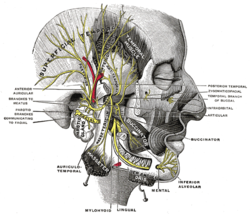- Muscles of mastication
-
Muscles of mastication Mandibular division of the trigeminal nerve. Latin musculi masticatorii Gray's subject #109 385 Origin Insertion Artery Nerve mandibular nerve Actions During mastication, four muscles of mastication are responsible for adduction and lateral motion of the jaw. Other muscles, usually associated with the hyoid such as the sternohyomastoid, are responsible for opening the jaw.
Contents
Muscles
- The masseter
- The temporalis (the sphenomandibularis is considered a part of the temporalis by some sources, and a distinct muscle by others)
- The medial pterygoid
- The lateral pterygoid
Each of these primary muscles of mastication is paired, with each side of the mandible possessing one of the four.
Innervation and embryological origin
Unlike most of the other facial muscles, which are innervated by the facial nerve (or CN VII), the muscles of mastication are all innervated by the trigeminal nerve (or CN V). More specifically, they are innervated by the mandibular branch, or V3. This is a testament to their shared embryological origin from the first branchial arch.
The muscles of facial expression, on the other hand, derive from the second branchial arch.
Origin and insertion
In humans, the mandible, or lower jaw, is connected to the temporal bone of the skull via the temporomandibular joint, an extremely complex joint which permits movement in all planes. The muscles of mastication originate on the skull and insert into the mandible, thereby allowing for jaw movements during contraction.
Function
The mandible is the only bone that moves during mastication and other activities, such as talking.
While these four muscles are the primary participants in mastication, other muscles are usually if not always helping the process, such as those of the tongue and the cheeks.
External links
List of muscles of head and neck: the head (TA A04.1, GA 4.378) Extraocular (CN III, IV, VI) oblique (inferior, superior) · rectus (superior, inferior, medial, lateral) · levator palpebrae superioris (superior tarsal)Mastication (CN V3) masseter · temporalis (sphenomandibularis) · pterygoid (lateral, medial)
fascia: Masseteric fascia · Temporal fascia · Deep portion: cementomaxillary tendon · Superficial portion: cementomandibular tendonFacial (CN VII) levator anguli oris · levator labii superioris · zygomaticus (major, minor)
orbicularis oris · risorius · buccinator
depressor anguli oris · depressor labii inferioris · mentalisPalate/fauces (CN IX, X, XI)
(except TVP=V3)veli palatini (tensor, levator) · musculus uvulae · palatopharyngeus (to pharynx) · palatoglossus (to tongue)Tongue (CN XII) extrinsic (genioglossus, hyoglossus/chondroglossus, styloglossus, and palatoglossus) · intrinsic (superior longitudinal, inferior longitudinal, transverse, vertical)Categories:- Muscles of the head and neck
Wikimedia Foundation. 2010.

